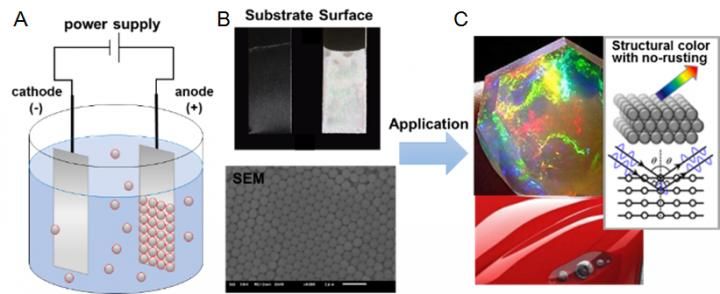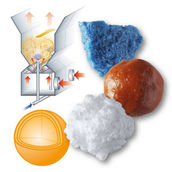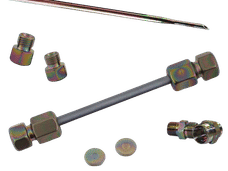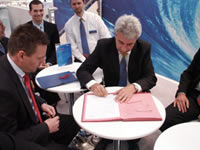New coating surface for superior rust resistance with 'colorless' color
Electrophoretic deposition coats metal with non-ionic polymer
Polymer chemists at Nagoya Institute of Technology in Japan invented a novel and simple coating process to color metals, leading to higher performance and saving the energy. The method involves a chemical modification to non-ionic polymers and nanotechnology.

A) Illustration of the electrophoretic deposition (EPD) of sulfone-containing nano-latex shows negatively charged nano-particles in suspension migrating towards the positive electrode. B) The anode coated with aligned nano-particles (top: electrode, bottom: SEM image. Scale bar, 2000 nm). C) Images of application example and the light reflection by the colorless nano-particles.
NITECH
Electrophoretic deposition is a standard industrial method for coating material and is especially used for rust prevention. Current methods, however, require a complex and expensive process that requires three coating steps, adding cost and time. Professor Akinori Takasu and his team report novel non-ionic polymers that can be used with electrophoretic deposition, simplifying the coating to just one step and significantly reducing energy demands.
The key to the discovery was the addition of a specific chemical group to the non-ionic polymer molecule.
"It was accidentally found in a project designing a new material for dental implant. When a non-ionic polymer had a sulfonyl group, it moved towards the anode in electrophoresis" explains Takasu.
Previously, the research team showed that the resulting coating becomes incredibly thick when the electrophoretic disposition is applied at low voltages. Combining a set of findings made it possible to skip multiple coating processes on a metal for rust resistance. However, for commercial purposes, it is important that the coat come in any desired color. Takasu and his colleagues therefore looked at how the color properties of non-ionic polymers behaved in water after applied as coating.
He says, "Our breakthrough was to include this non-ionic polymer into nano-particles. The new particles show structural color like opal stones, a.k.a. colorless color. The wavenumber of the particle should be controllable by changing the size of the particles used to coat the surface," which determines the color emitted.
While Takasu could easily react the non-ionic polymers with the sulfonyl group, he found controlling for the size of the particles proved difficult. In this research, he and his team developed the size control technology and prepared the particles by soap-free emulsion copolymerization, which consistently gave nanoparticles 300 nm in size as an example. They then oxidized the particles in water to generate the sulfonyl group. Finally, electrophoretic deposition was applied to coat steel. Electron microscopic images confirmed that the particles uniformly covered the steel in a honeycomb pattern.
"I expect our study will lead to a new type of electrophoretic painting that can be applied to any coating technologies like cars and fibers," Takasu said. This technique overcomes problems such as color fading and damage from UV radiation because of structural coloring, thus will be provided for wider application of electrophoretic dispersion.
Original publication
Other news from the department science
These products might interest you

OCA 200 by DataPhysics
Using contact angle meter to comprehensively characterise wetting behaviour, solids, and liquids
With its intuitive software and as a modular system, the OCA 200 answers to all customers’ needs

Tailor-made products for specific applications by IPC Process Center
Granulates and pellets - we develop and manufacture the perfect solution for you
Agglomeration of powders, pelletising of powders and fluids, coating with melts and polymers

Dursan by SilcoTek
Innovative coating revolutionizes LC analysis
Stainless steel components with the performance of PEEK - inert, robust and cost-effective

Get the chemical industry in your inbox
By submitting this form you agree that LUMITOS AG will send you the newsletter(s) selected above by email. Your data will not be passed on to third parties. Your data will be stored and processed in accordance with our data protection regulations. LUMITOS may contact you by email for the purpose of advertising or market and opinion surveys. You can revoke your consent at any time without giving reasons to LUMITOS AG, Ernst-Augustin-Str. 2, 12489 Berlin, Germany or by e-mail at revoke@lumitos.com with effect for the future. In addition, each email contains a link to unsubscribe from the corresponding newsletter.
Most read news
More news from our other portals
Last viewed contents
Saturation_vapor_density
Arthur_Compton
Metal-semiconductor_junction

BASF and TU Berlin launch artificial intelligence cooperation

KROHNE concludes framework contract with Uhde
Gollub-Swinney_circular_Couette_experiment
Phar-Mor





























































